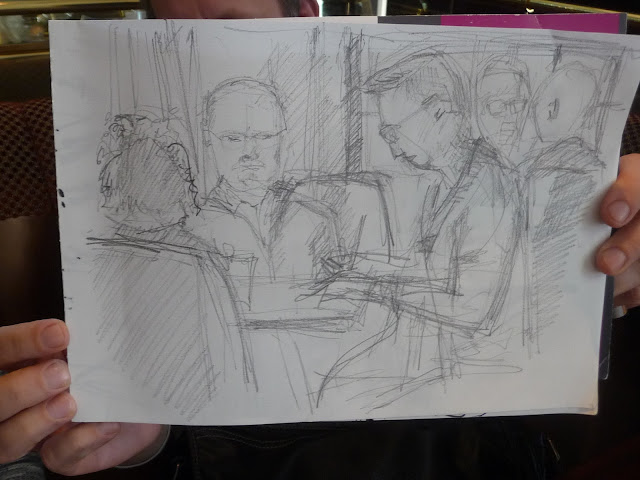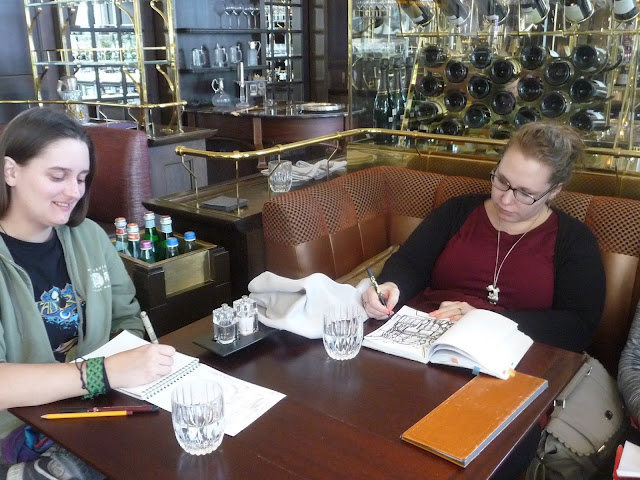38. közös rajzolás 2016. február 6-án
a Kollázs Braaserie & Bárban
38. Group Sketching at Gresham
A szép cím mögött a Hotel Four Seasons kávéháza, vagy ahogy az idősebbek ismerik.a Gresham kávéház rejlik,
A szép szecessziós épület története:
Quittner Zsigmond és a Vágó fivérek tervei alapján épült 1907-ben, a londoni The Gresham biztosítótársaság budapesti
székházaként. A szobrokat Telcs Ede, Maróti Géza
és Ligeti Miklós alkotta, az üvegablakokat és mozaikokat Róth Miksa, a híres
kerámia burkolatot a Zsolnay-gyár készítette, a míves kovácsoltvas elemeket
pedig Jungfer Gyula. A földszinten üzemelt a legendás Gresham Kávéház, amely a
húszas évek kiemelkedő művészeinek otthonául szolgált. A Gresham-körhöz olyan
neves alkotók tartoztak, mint például Bernáth Aurél, Egry József, Márffy Ödön
és Ferenczi Béni. Igaz, hogy a nagy gazdasági válság után a biztosítótársaság
kivonult a Magyarországról, még sem ez okozta az épület vesztét. A második
világháborúban és az azt követő időszakban kezdődött a tartós romlás. 1948-ban államosították a Greshamet, a
lakosztályokból kisebb lakásokat alakítottak ki. Az azt követő negyven évben
pedig a Duna-parti komplexum teljesen tönkrement, a Zsolnay burkolatnak
mindössze 30 százaléka maradt meg.
1987 óta más
Duna-parti épületekkel együtt a Világörökség része. Az 1990-es évek második felében dőlt el a Gresham
sorsa: négycsillagos szálló lesz belőle. Ám a felújítás jóval hosszabb ideig
tartott a tervezettnél, végül 2004 nyarára készültek el a korhű
rekonstrukcióval. 2004-ben teljes felújítás után, mint 179
szobás luxusszálloda nyílt meg Four
Seasons Gresham Palace Hotel néven.
You might want to know more about this location:
The Four Seasons Hotel Gresham Palace, which opened again in 2004, started life as a temple to capitalism, created in 1907 for the London Gresham Life Assurance Society.
In 1999, the Canadian-based Four Seasons Hotels and Resorts and Gresco Investments Ltd. signed a development agreement the District V local council to restore the building to its former glory and create a luxury, 179-room (including 14 suites) five-star hotel at a cost of some $84 million.
The site where the Gresham Palace now stands originally housed a neo-classic palace called the Nako House, designed by József Hild and built in 1827 by wholesale merchant Antal Deron.
In 1880, the London Gresham Life Assurance Company bought the Nako House as its foreign headquarters on this site but then, in 1903, decided to demolish the Nako House and build from scratch.
The Gresham Palace was designed by Zsigmond Quittner and the Vágó brothers and took three years to build, finally opening its grand gates in 1907.
The building was conceived as a kind of monument to Sir Thomas Gresham (1519-1579) the 16th century financier to Queen Elizabeth I, founder of London’s Royal Exchange and inventor of Gresham’s Law which states that, “Where legal tender laws exist, bad money drives out good money”.
The time of completion occurred during Hungary’s Golden Age and some of the most famous artists and craftsmen of the time worked to make the Gresham Palace one of the most glamorous buildings in Pest, and one of the finest examples of Art Nouveau architecture in the world. The artist Géza Maróti created many original sculptures for the building.
Sculptor Ede Telcs created the relief of Thomas Gresham looking a bit like a jaunty sea captain at the top of the facade (shown in the picture at the top of this article), staring out at a slight angle to the Danube and across the Chain Bridge towards Buda.
The Gresham Palace was one of the first buildings in Budapest to have its Art Nouveau exterior illuminated at night and no expense was spared on the decor and the embellishments inside either.
Every bathroom and kitchen was fitted with ceramic tiles from the Pécs Zsolnay porcelain factory and Miksa Róth was commissioned to make the gorgeous stained glass windows on every landing.
The wrought iron peacock gates came from the prestigious Gyula Jungfer workshop and furniture maker Endre Thek was commissioned to fill the rooms with his elegant creations.
The Gresham building also featured state-of-the-art technology, full electrical wiring, central heating, two-meter-thick cellar walls to prevent flooding and something known as a ‘central vacuum system’ which was a kind of communal vacuum cleaner which wound its way around the building.
Cleaners only had to connect a tube to a nozzle in the wall of the apartment and there was instant suction.
The ground floor and first floor hosted the Gresham Company’s offices, the Gresham Café and a finishing school for daughters of the aristocracy called “English Young Ladies”.
The second and third floors were comprised of around half a dozen luxury apartments where many of the country’s elite took rooms. Government minister Count Gyula Andrássy took rooms in the Gresham Palace, his brother Géza was conveniently chairman of the board of the Gresham Company’s Hungarian subsidiary.
The fourth floor contained more modest apartments for the company’s traveling insurance salesmen while the fifth floor just under the roof housed the servants’ quarters.
Between the wars, the Gresham Café was the meeting place for the Gresham Circle of artists. The Podium Cabaret in the basement was the place where Bohemian artists rubbed shoulders with fur-clad aristocrats while they watched the risqué and satirical shows.
The cabaret was closed for a time in the twenties for being too ‘daring’ but enjoyed a second lease of life between 1936 and the outbreak of the War.In the Café above, important figures such as István Szőnyei, József Egry, Pál Pátzay and Jenő Barcsay discussed new movements in art.
The radical Nagybánya school gathered here as did writers and artists, all followers of a movement that urged a humanist, respectful approach to art, one that preserved the values of the past.
The Gresham Circle ceased to exist in 1944.
During World War II, the building was hit bombarded from across the river by revolutionaries trying to dislodge the Russians from the Interior Ministry next door.
During the winter of 1944-45 Soviet soldiers occupied the Gresham Palace and burnt much of the furniture to keep warm while the residents huddled in the cellar.
When the Chain Bridge was blown up during the German retreat, the shock waves blew the peacock gates on Mérleg utca right off their hinges.
In 1948 the Hungarian Communist Government nationalized Gresham Palace and scores of new tenants moved in, sub-dividing the palatial apartments into smaller flats.
The Gresham Café managed to keep going through the grim fifties and sixties, and in 1957 even had the first Wurlitzer organ in the country.
Between 1948 and 1990, the building declined into a sad state disrepair.
The café closed and a Chinese restaurant took its place, then a casino moved in.
Small businesses, a hairdresser and a locksmith moved into the arcade but all around the walls were crumbling.
In the seventies, the building was listed as national protected landmark in the late 1970s and in the 1976 list of protected monuments the Gresham is described as being 'of monument character'.
With the change of political system in 1990, the Government transferred ownership of Gresham Palace to the District V Council.
Oberoi, an Indian hotel chain offered to restore the palace in return for permission to turn it into a hotel.
A deal was announced in 1991, however the Council had not considered the 38 remaining tenants of the building.
Much legal wrangling ensued and four years later, Oberoi had lost patience and sold its interests to Fejér & Associates.
In 1997, Gresco entered the picture and arranged for the Four Seasons Hotels and Resorts to manage and operate Gresham Palace.
Gresco agreed to the National Board for the Protection of Historic Monuments (OMVH) which had earlier granted license on condition that the exterior, the ceramic decorations, the glass interior arcade and the stained glass windows on every staircase be restored in a sensitive manner.
Tizenketten gyűltünk össze ezen a szépséges helyen. Volt akit a berendezés szecessziós pompája ragadott meg, volt akit a kávézgató vendégek, vagy a személyzet.
About 12 of us gathered at the Café for an early morning sketch. Each of us picked on the subject we found the most interesting...the stunning interior, the sleepy guests or the busy waiters.
Réka
Anna
Zsuzsa
Zsuzsa
Sokan örökítették meg a közös rajzolást.
...and some depicted the group at work....
Zsuzsa
Anna
Zsuzsa
Örs
Segítsetek: kinek az alkotása? Rossz a memóriám.
Anna
Erika
Dóri
Az ablakból gyönyörű kilátás nyílt a Széchenyi térre. Készült is néhány kép_
....some of us were mesmerized by the view...
István
Zsuzsa
Íme a teljes termés:
...and all finally together...
Most látom, hogy nem minden rajzról készült fénykép, elnézést az alkotótól. Ha tudja, küldje át a címemre, majd beillesztem ide utólag.
Végül, ahogy készülnek az alkotások
Továbbra is várom rajzaitokat, akár közös rajzoláson, akár máskor készültek ligetizsuzsa@t-online.hu címre.



























Nincsenek megjegyzések:
Megjegyzés küldése